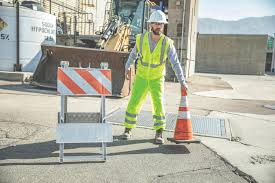Construction workers are known for wearing bright, high-visibility clothing on job sites. These garments typically come in shades of yellow, orange, and green and are designed to make workers more visible to others, especially in low-light conditions. Here are some reasons why construction workers wear bright colors:
Safety:
The primary reason for wearing high-visibility clothing is safety. Construction workers operate in hazardous environments where visibility can be limited, such as construction sites or busy roads. By wearing bright colors, workers can make themselves more visible to motorists, heavy machinery operators, and other workers. This can reduce the risk of accidents and injuries.
Compliance:
Many countries have regulations that require workers in certain industries to wear high-visibility clothing. For example, in the United States, the Occupational Safety and Health Administration (OSHA) mandates that workers on highway construction sites must wear reflective vests or jackets. Compliance with these regulations is necessary to ensure worker safety and avoid legal consequences.
Identification:
On large construction sites, it can be challenging to keep track of workers, especially if they are spread out over a large area. High-visibility clothing can make it easier to identify workers and keep track of who is where. This can be especially important in emergency situations when quick identification and communication are critical.
Branding:
Some construction companies use high-visibility clothing as a form of branding. They may have their logo or company name printed on the clothing to help promote their business and create a consistent image among their workers. This can also help to create a sense of unity and pride among the workers.
Comfort:
High-visibility clothing is typically designed to be comfortable and functional, with features such as moisture-wicking fabrics, breathable mesh panels, and adjustable straps. This can help workers stay cool and comfortable in hot, humid conditions or when performing physically demanding tasks.
Improved communication:
Brightly colored clothing can help to facilitate communication between workers. For example, when signaling or directing heavy machinery, workers need to be able to see and understand each other clearly. High-visibility clothing can make it easier for workers to communicate and avoid misunderstandings.
Cost-effectiveness:
High-visibility clothing is relatively inexpensive compared to other safety measures such as barriers, warning lights, or electronic signaling devices. By providing workers with high-visibility clothing, companies can improve safety on job sites without incurring significant costs.
Regulatory compliance:
In some cases, high-visibility clothing is required by law. For example, in the UK, the Personal Protective Equipment Regulations require that employers provide high-visibility clothing to workers who operate in hazardous environments such as construction sites, highways, and railways.
In conclusion, construction workers wear bright colors to improve their visibility and safety on the job site. High-visibility clothing can help workers identify each other, communicate effectively, and avoid accidents and injuries. It is also often required by law, and can be a cost-effective and comfortable way to improve worker safety.

